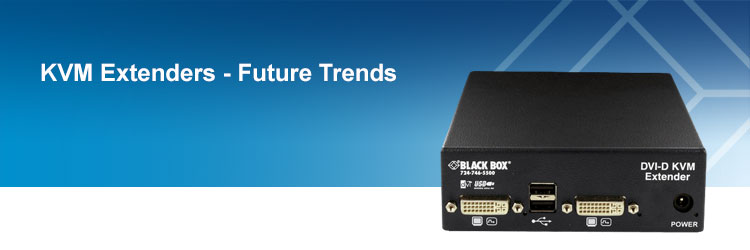NavigationWhitepaper |

KVM Extenders - Future Trends1. IntroductionIn today’s IT world, screen-based workstations can be found in many different areas, from the traditional work place in the office, as well as on the production floor for machine control. Many more types of screen-based workstations do exist and most of them can be associated with the office sphere (e.g. POS – point of sale counters, workplaces at hospitals, especially in the operating theater, the exam room in doctor offices or the treatment room). At many screen-based workstations, the PC is located under the desk. In areas that are at the front line to the client, such as reception desks, bank counters and other similar service counters, this may be undesirable as it makes a bad optical impression. In a recording or video cutting studio, the noise that is created by the fans may prevent productive work entirely. In the widest sense, automatic teller machines can also be seen as screen-based workstations, where the computer needs to be protected against vandalism. These are only some examples for keeping the computer from “the harm’s way“ or to provide a productive and ergonomic work environment. 2. Traditional KVM Extender technologies of yesterday and todayIn the early days, the simple extension cables were used to shift screen-based workstations. Even today, this option can fulfil its purposes for the short distances. Then there were various solutions using proprietary cables based on coaxial conductors as KVM (keyboard/mouse/monitor) extenders. However these have vanished completely from the market in favor of other technologies. Today’s transmission medium is copper wire (CATx) or fiber. The key selection criteria for KVM extenders are the desired resolution for the video signal and the distance that needs to be covered. Even though they are not explicitly mentioned here, it goes without saying that the keyboard and mouse signals can be transmitted simultaneously. These peripheral signals require only very little bandwidth, therefore they are quite immune to interferences. However, the video signal is the most visible and the guiding component. Requirements for KVM extenders have increased significantly. In the early days, only analog video signals with a VGA resolution (640x480) were transmitted. While today, SXGA (1280x1024) has become the standard at the workstation. Image resolutions are still higher at CAD and graphic workstations (1920x1200 and higher). The increasing use of digital video signals (DVI), instead of conventional analog transmissions, has to be considered as well. 3. KVM via optical fiberWhen transmitting an analog video signal via optical fiber, the sophisticated KVM extenders usually digitalize the signal first and then transmit it via two optical fiber strands. With multi-mode optical fibers (50/125) distances of up to 500 meters can be covered, and up to 10 kilometers with single-mode fibers. However, there are certain limitations of the general application due to the bandwidth requirements of the digitalization, such as a restricted maximum resolution or reduced frame rate (images per second) at high resolutions. The latter in particular may cause juddering images. While this may be fully sufficient and acceptable for applications with static content, such results are not at all wanted at workstations where graphics and animated pictures are processed. 4. KVM via CAT cablesProblems increasingly occur in analog transmissions via CAT cables as well. Instead of utilizing the once commonly used CAT5 cables, today CAT6 or CAT7 cables with shielded wire pairs are installed. The higher category cables have been optimized for network transmissions, but not for the transmission of video signals. The most common misconception among users is to mistake the use of a CAT cable for a digital signal transmission. The CAT cable is used only as a transmission media, while the transmitted signal is still analog. This means, that the signals cannot be transmitted via network switches or sections of optical fiber within the network. The VGA signal consists of red, blue, green and synchronization signal. The analog red signal is transmitted via the first pair of the CATx cable, the blue signal via the second pair, and the third cable pair transmits the green signal altogether with the synchronizing signal (sync). The fourth pair is used for the remaining signals such as keyboard, mouse and others, e.g., serial data, audio or the like. The signal assignment as well as the electrical data transmitted via CAT cables are not standardized. It is therefore impossible to mix transmitter and receiver units from different manufacturers. 4.1 Technical detail: skew effects induced by CAT cablesTo reduce crosstalk between wire pairs in CATx cables, the individual pairs have different twist ratios. The difference in twist ratios results in different effective copper lengths of the individual wire pairs. This difference in length between the pairs in turn leads to different runtimes of the red, blue, and green analog color signals. The specification of the runtime difference within a cable can be found in the data sheet of the cable under the term "Skew" and is specified in nanoseconds. The specified value refers to a cable cut length of 100m network segment length and is 20ns on average. For short cable lengths and low image resolutions, respectively, the skew value can be neglected. An increase in VGA resolution and/or cable length, however, may cause color shades on the display. At best, the runtime differences only cause blurs; at worst, color offset may occur which is clearly apparent at vertical lines. A white line for example might then have an undesirable red shadow. According to the standard, the permissible runtime differences decrease for shielded wire pair cables. Experience has shown, that the additional shielding causes capacitive effects that result in streaking. This can only partly be rectified by the compensation settings of the KVM extenders. The maximum achievable distances are approximately 300 meters. In addition to this, electrical interferences may increasingly occur. Generally speaking, the higher the desired VGA resolution, the shorter the achievable distance. The highest video quality is achieved if solid U/UTP or S/UTP with a wire cross section of at least AWG24 is used to connect the transmitter and the receiver of the extender. KVM Extenders are often used in conjunction with KVM Switches, sometimes they are even built-into the KVM Switch. By controlling the KVM Switch remotely (from outside the server room), the administrator receives a comfortable and ergonomic workplace away from the noise of the servers and the chilliness of the air-conditioned server room. It also saves him from bustling between the various servers/server rooms. 
Lossy to lossless compression 5. KVM Extenders for digital video (DVI)Not only that the screen resolution requirements have changed, the video signal type has changed as well. Working with the digital video signals (DVI) is on the increase. The advantages of DVI are very obvious: The A-D conversion at the monitor and the graphic card are not necessary any more, and there are no visible losses due to the digital signal transmission. However, a DVI signal requires a considerably higher bandwidth than a corresponding analog video signal. This leads to entirely different requirements for KVM Extenders. DVI cables can only cover a distance of five meters according to the standard. The data rate of a single-link DVI signal is 3.96Gbit/s, the maximum resolution is 1920x1200. Also digital KVM extenders support CATx or optical fiber as transmission media. Often compression is used, since the bandwidth of a DVI signal is considerably higher than that of a CATx cable. Occasionally, the frame rate and/or color depth is reduced from 24 bits to 21 or 18 bits. Graphic designers will notice the difference in color depth, but these losses are irrelevant in standard applications. Although the transmission via the CATx cable itself is digital, as with analog KVM extenders. However, the signal has nothing to do with TCP/IP and the transmission is solely a proprietary. The maximum range via copper is around 140 to 150 meters. Optical fiber cables provide a higher bandwidth, therefore the transmission over greater distances is possible. The video signal is compressed in such a way that the transmission itself is typically at 1 Gbit/s and 1.25 Gbit/s. Models with a 2.5 Gbit/s link that do not reduce the color depth are also available. The optical fiber variants normally use two fibers, as an option, single fiber is also possible. PS/2 keyboards and mice are more and more replaced by equivalent USB input devices. Only a few KVM Extenders transmit the USB signal transparently. More frequently, emulation and enumeration is used to support devices with the USB-HID (Human Interface Device) standard (e.g. MS wheel mouse). In this case, Multimedia keys on the keyboard or additional mouse keys are either not or only partly supported. However, Black Box offers digital KVM Extenders with full support of extended keyboard and mouse functions as well as an option with programmable USB HID ports to configure special requirements. Newer developed models are available that do not only transmit DVI uncompressed over a single optical fiber but also completely transparent USB 2.0 at a speed up to 480Mbps supporting demanding USB devices such as Wacom graphic tablets. Most DVI extenders available have one disadvantage: they only transmit the digital DVI-D signal. No analog signal (e.g. VGA with a plug adapter) can be transmitted. Some of the KVM Extenders from Black Box support both VGA and DVI inputs, please contact our Free Tech Support for more details. 5.1. CATx requirements for digital video extensionSince DVI extenders process and transmit the signals purely digital comparable to Ethernet Layer1, the CATx cable recommendation for digital KVM extenders equals the cable requirements of a state-of-the-art network: the better the cable is suitable to transport Ethernet data, the better it will fit for DVI KVM extensions. General recommendations are:
6. KVM extenders for analog and digital video via TCP/IPOne of the KVM technology developments is a flexible KVM Extender for DVI and VGA, These devices don’t use a proprietary protocol or signal for the transmission, they transport the signals via a Gigabit Ethernet instead. The transmission can be routed or extended by means of a Gigabit switch at any time and any distance within the network. With a simple media converter, it is also possible to switch from copper to optical fiber anywhere in the transmission path, should an increased range or galvanic isolation be required. Because of the high bandwidth required for the transmission of the KVM signals, it is not recommended to transmit the KVM data stream of larger applications through the regular in-house network. ConclusionThis little overview might have given already an impression about the variety of KVM Extenders available on the market being more or less qualified for a certain application. A user, who works just sporadicly at a remote computer with a low resolution, requires a different extension solution than a 24/7 user console or a graphic power user with the need to access different sources and peripherals. Also an industrial or other environment with high EMI interferences has different requirements as a standard office. If a certain image quality or special functions (e.g. transparent USB) are desired, the adding of certain costs are often being underestimated during the planning. Even for minor details, such as DDC handling, are important for the KVM extension to function properly. Before buying a KVM extender, Black Box recommends to contact a product expert already in the planning stages to check and determine all requirements of the KVM Extender needed. Usually they can offer a few KVM Extenders that are suitable for the purpose, determine and test the optimum solution that offers the best value for the money. |